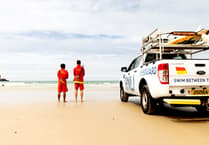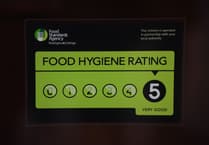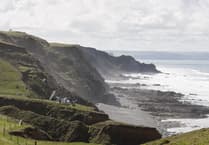DESPITE lockdown, Launceston town crier Rob Tremain did not want to let this important day in Cornwall’s calendar pass by without some acknowledgement. Below is what he would have said in the town square today if coronavirus restrictions had allowed.
ON this day we look back to the past and to the arrival in Cornwall of this Saint, who came as an outsider, but made Cornwall his home. A familiar story.
St Piran is known as the merriest, hardest-drinking, hardest-living holy man Cornwall ever knew. He is also the Patron Saint of Tinners, and his feast day used to be kept as a holiday in the parishes of Perranzabuloe, St Agnes and St Day, and others where tin mining has been the main occupation.
Piran was born in Ireland, where he became renowned for his miraculous deeds.
For several years he advised King Aengus of Munster and confessed his sins; then the King grew tired of his wife and coveted a lady of the court, younger and more beautiful. The King wished to put away his wife and marry the other.
Piran saw it was his duty to forbid this, and preached against the King before all the court.
This so angered the King that he commanded that Piran be bound to a millstone and thrown off the high cliffs. On a cold winter’s day, the saint was bound to the heavy stone and cast over the edge towards the waters below.
When the stone hit the sea, everyone was astounded to see that Piran’s bounds were loosed and the stone itself actually floated. It sailed him far away from Ireland, amid the storms and waves of the Celtic Sea, until at last it came ashore on the North coast of Cornwall on the beach that bears his name today – Perranporth.
The date was March 5, which is still observed as Saint Piran’s Day. So, he began his life in Cornwall teaching the Gospel, and helping the people. He looked after nature and befriended a fox, a badger and a wild boar.
Piran loved a good story and he enjoyed a good feast with the best wine and ale; he always joined in the celebrations of his flock, whether it was a wedding, a parish holiday, a wrestling tournament or a funeral wake.
Piran was fond of his drink, and the antics of the local people at the revels led to the phrase “As drunk as a Perraner”.
Piran is credited with the discovery of tin in Cornwall. One cold night he built a larger fire than usual in his dwelling and was sitting before it when he noticed white metal flowing from the black hearth stone. We Cornish have been trading tin all over the world ever since.
St Piran’s flag has become the national banner of Cornwall; a white cross on a black ground, symbolising the light of Christ in a dark world, and also the white tin ore against the black rock.
As well as looking back to St Piran, we also look to the future. It is a day when young people join in our old traditions and get to know more of our unique Celtic Cornish heritage. It is they who will carry his banner forward.
We Cornish have an historical linguistic and cultural heritage quite distinct in the UK.
Some of us Cornish feel we are part of a nation, and outsiders see Cornwall and its people as different. We have our own language, music, heritage and traditions.
In April 2014, Cornwall was fully recognised under European rules for the Protection of National Minorities. The decision to recognise the unique identity of the Cornish now affords us the same status (under the European Framework Convention for the Protection of National Minorities) as the UK’s other Celtic people, the Scots, the Welsh and the Irish.
For the first time the Government has recognised the distinctive culture and history of the Cornish. And the Cornish language is the only language in England recognised under the Council of Europe’s Charter for Regional or Minority Languages.
We are all special and Cornwall’s greatest opportunities lie in our distinctiveness. Be proud to be Cornish. This year is a census year and we can show our Cornishness on the form.
Keep safe, and best wishes to you all.
Rob Tremain, Cryor an Dre Lanstefan.
KERNOW BYS VYKEN




